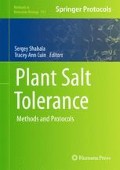Abstract
Soil salinity devastates agriculture. It reduces crop yields and makes arable land unsuitable for later use. Many species have evolved highly efficient strategies to sense, transduce, and build up tolerance to high salinity and even sensitive species have endogenous mechanism for coping with this stress. These underlying physiological and metabolic mechanisms can be unraveled using metabolomics. Here we describe detailed protocols of how to extract polar metabolites for analysis using GC-MS and LC-MS. We also touch briefly on considerations that should be taken into account when designing the experiment and how the resulting data may be analyzed and visualized in a biological context.
Access this chapter
Tax calculation will be finalised at checkout
Purchases are for personal use only
References
Yokoi S, Bressan RA, Hasegawa PM (2002) Salt stress tolerance of plants. JIRCAS Working Report. p 25–33
Mittler R, Blumwald E (2010) Genetic engineering for modern agriculture: challenges and perspectives. Annu Rev Plant Biol 61:443–462
Munns R (2002) Comparative physiology of salt and water stress. Plant Cell Environ 25:239–250
Munns R (2005) Genes and salt tolerance: bringing them together. New Phytol 167:645–663
Bowne J, Bacic A, Tester M, Roessner U (2011) Abiotic stress and metabolomics. Annu Plant Rev 43:61–85
Sanchez DH, Siahpoosh MR, Roessner U, Udvardi U, Kopka J (2008) Plant metabolomics reveals conserved and divergent metabolic responses to salinity. Physiol Plant 132:209–219
Roessner U, Beckles DM (2009) Metabolite measurements. In: Schwender J (ed) Plant metabolic networks. Springer, New York
Sanchez DH, Pieckenstain FL, Escaray F, Erban A, Kraemer U, Udvardi MK, Kopka J (2011) Comparative ionomics and metabolomics in extremophile and glycophytic Lotus species under salt stress challenge the metabolic pre-adaptation hypothesis. Plant Cell Environ 34:605–617
Sanchez DH, Pieckenstain FL, Szymanski J, Erban A, Bromke M, Hannah MA, Kraemer U, Kopka J, Udvardi MK (2011) Comparative functional genomics of salt stress in related model and cultivated plants identifies and overcomes limitations to translational Genomics. PLoS One 6:e17094
Salt DE, Baxter I, Lahner B (2008) Ionomics and the study of the plant ionome. Annu Rev Plant Biol 59:709–733
Kusano M, Tohge T, Fukushima A, Kobayashi M, Hayashi N, Otsuki H, Kondou Y, Goto H, Kawashima M, Matsuda F, Niida R, Matsui M, Saito K, Fernie AR (2011) Metabolomic approaches toward understanding nitrogen metabolism in plants. J Exp Bot 62:1439–1453
Roessner U, Patterson JH, Forbes MG, Fincher GB, Langridge P, Bacic A (2006) An investigation of boron toxicity in barley using metabolomics. Plant Physiol 142:1087–1101
Widodo PJH, Newbigin E, Tester M, Bacic A, Roessner U (2009) Metabolic responses to salt stress of barley (Hordeum vulgare L.) cultivars, Sahara and Clipper, which differ in salinity tolerance. J Exp Bot 60:4089–4103
Tavakkoli E, Pichu R, McDonald GK (2010) The response of barley to salinity stress differs between hydroponic and soil systems. Funct Plant Biol 37:621–633
Munns R, Tester M (2008) Mechanisms of salinity tolerance. Annu Rev Plant Biol 59:651–681
Long TA (2011) Many needles in a haystack: cell-type specific abiotic stress responses. Curr Opin Plant Biol 14:325–331
Beckles DM, Roessner U (2011) Plant metabolomics—applications and opportunities for agricultural biotechnology. In: Altmann A., Hasagawa PM (eds) Plant biotechnology and agriculture: prospects for the 21st century. Elsevier, London
Jacobs A, Lunde C, Bacic A, Tester M, Roessner U (2007) The impact of constitutive expression of a moss Na+ transporter on the metabolomes of rice and barley. Metabolomics 3:307–317
Callahan DL, De Souza D, Bacic A, Roessner U (2009) Profiling of polar metabolites in biological extracts using diamond hydride-based aqueous normal phase chromatography. J Sep Sci 32:2273–2280
Junker BH, Klukas C, Schreiber F (2006) VANTED: a system for advanced data analysis and visualization in the context of biological networks. BMC Bioinformatics 7:109
Kopka J, Schauer N, Krueger S, Birkemeyer C, Usadel B, Bergmüller E, Dörmann P, Weckwerth W, Gibon Y, Stitt M, Willmitzer L, Fernie AR, Steinhauser D (2005) GMD@CSB.DB:the Golm metabolome database. Bioinformatics 21:1635–1638
Roessner U, Nahid A, Hunter A, Bellgard M (2011) Metabolomics—the combination of analytical chemistry, biology and informatics. In: Moo-Young M, Butler M, Webb C, Moreira A, Grodzinski B, Cui ZF, Spiros A (eds) Comprehensive biotechnology, 2nd edn. Elsevier, New York
Rao SR, Ford KL, Cassin AM, Roessner U, Patterson JH, Bacic A (2010) Proteomic and metabolic profiling of rice suspension culture cells as a model to study abscisic acid signalling response pathways in plants. J Proteome Res 9:6623–6634
Author information
Authors and Affiliations
Corresponding author
Editor information
Editors and Affiliations
Rights and permissions
Copyright information
© 2012 Springer Science+Business Media, LLC
About this protocol
Cite this protocol
Roessner, U., Beckles, D.M. (2012). Metabolomics for Salinity Research. In: Shabala, S., Cuin, T. (eds) Plant Salt Tolerance. Methods in Molecular Biology, vol 913. Humana Press, Totowa, NJ. https://doi.org/10.1007/978-1-61779-986-0_13
Download citation
DOI: https://doi.org/10.1007/978-1-61779-986-0_13
Published:
Publisher Name: Humana Press, Totowa, NJ
Print ISBN: 978-1-61779-985-3
Online ISBN: 978-1-61779-986-0
eBook Packages: Springer Protocols

